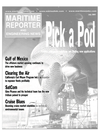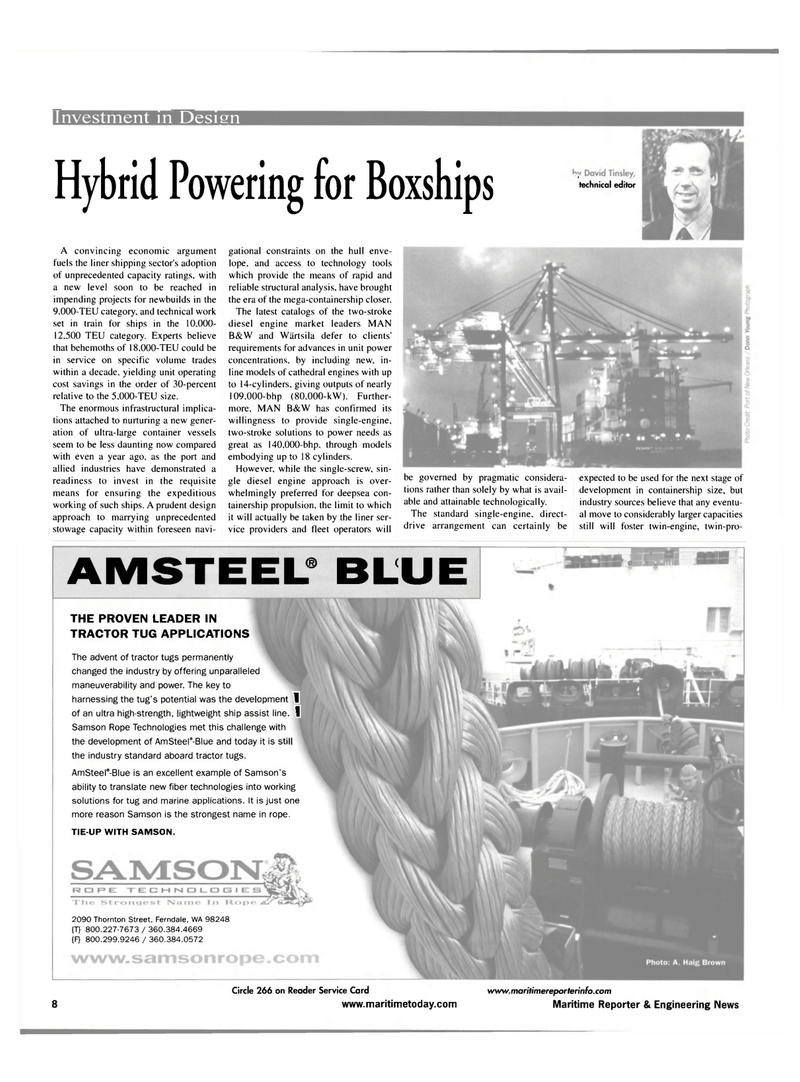
Page 8: of Maritime Reporter Magazine (July 2001)
Read this page in Pdf, Flash or Html5 edition of July 2001 Maritime Reporter Magazine
Investment in Desmn
Hybrid Powering for Boxships —
AMSTEEL BLUE
A convincing economic argument fuels the liner shipping sector's adoption of unprecedented capacity ratings, with a new level soon to be reached in impending projects for newbuilds in the 9,000-TEU category, and technical work set in train for ships in the 10.000- 12,500 TEU category. Experts believe that behemoths of 18.000-TEU could be in service on specific volume trades within a decade, yielding unit operating cost savings in the order of 30-percent relative to the 5,000-TEU size.
The enormous infrastructural implica- tions attached to nurturing a new gener- ation of ultra-large container vessels seem to be less daunting now compared with even a year ago, as the port and allied industries have demonstrated a readiness to invest in the requisite means for ensuring the expeditious working of such ships. A prudent design approach to marrying unprecedented stowage capacity within foreseen navi- gational constraints on the hull enve- lope, and access to technology tools which provide the means of rapid and reliable structural analysis, have brought the era of the mega-containership closer.
The latest catalogs of the two-stroke diesel engine market leaders MAN
B&W and Wiirtsila defer to clients' requirements for advances in unit power concentrations, by including new, in- line models of cathedral engines with up to 14-cylinders. giving outputs of nearly 109,000-bhp (80,000-kW). Further- more, MAN B&W has confirmed its willingness to provide single-engine, two-stroke solutions to power needs as great as 140,000-bhp. through models embodying up to 18 cylinders.
However, while the single-screw, sin- gle diesel engine approach is over- whelmingly preferred for deepsea con- tainership propulsion, the limit to which it will actually be taken by the liner ser- vice providers and fleet operators will be governed by pragmatic considera- tions rather than solely by what is avail- able and attainable technologically.
The standard single-engine, direct- drive arrangement can certainly be expected to be used for the next stage of development in containership size, but industry sources believe that any eventu- al move to considerably larger capacities still will foster twin-engine, twin-pro-
THE PROVEN LEADER IN
TRACTOR TUG APPLICATIONS
The advent of tractor tugs permanently changed the industry by offering unparalleled maneuverability and power. The key to harnessing the tug's potential was the development 1 of an ultra high-strength, lightweight ship assist line, jl
Samson Rope Technologies met this challenge with the development of AmSteel'-Blue and today it is still the industry standard aboard tractor tugs.
AmSteef-Blue is an excellent example of Samson's ability to translate new fiber technologies into working solutions for tug and marine applications. It is just one more reason Samson is the strongest name in rope.
TIE-UP WITH SAMSON. 2090 Thornton Street, Ferndale, WA 98248 {T} 800.227-7673 / 360.384.4669 {F} 800.299.9246 / 360.384.0572
Circle 266 on Reader Service Card www.maritimereporterinfo.com 8 www.maritimetoday.com Maritime Reporter & Engineering News

 7
7

 9
9
